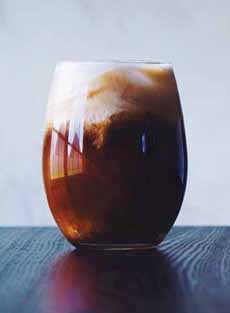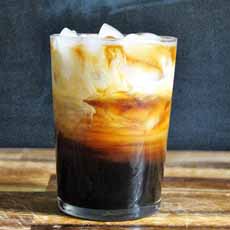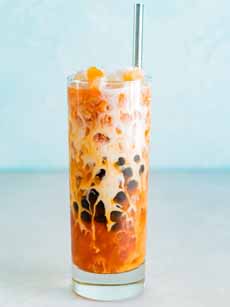TIP OF THE DAY: Cut The Calories In Thai Iced Tea & Thai Iced Coffee
 The milky swirl of Thai iced tea or coffee is a visual treat (photo © Wife Mama Foodie).
|
June is National Tea Month, time for an article on a type of iced tea not yet as broadly served in the U.S. as we think it should be. The easy recipe follows. For those who already know and love Thai iced tea or coffee but not the overload of sugar, we have a solution below. But first, some history about the drinks. Thai iced tea, known as cha-yen in Thailand (cha is the word for tea), is served in Thailand, Vietnam, elsewhere around the Pacific Rim, and in Thai restaurants around the world. It is made from strong-brewed black tea—typically Ceylon tea—and sweetened condensed milk, which adds creaminess, body and mouthfeel. For visual appeal, the deep amber tea and white sweetened condensed milk (and often, evaporated milk) are swirled together or layered. The drink can be topped off with evaporated milk, coconut milk, half and half, or whole milk. It is sweetened with lots of sugar (local to the the South Pacific), and often served over crushed ice. The brewed tea can be enhanced with spices, such as cardamom, clove, nutmeg, orange blossom water, star anise, and tamarind. If you like chai tea with milk and sweetener, you are likely to enjoy Thai iced tea. The countries where it’s most popular are known for hot, steamy summers. Thai iced tea is a welcome refreshment—and a complement to spicy food. If your neck of the woods is as hot and steamy as ours is, it’s time to try the recipe. In hot countries before refrigeration, where fresh milk was hard to come by, evaporated milk and sweetened condensed milk were used in coffee, desserts, and other recipes requiring milk (including Key lime pie). The precise birth date of what is now known today as Thai tea is uncertain. Americans and Europeans living in Asia brought evaporated milk and sweetened condensed milk—first available in 1856—for their tea and coffee [source]. One source suggests that “It was probably introduced during the time of Field Marshall Pibul Songkram [1938 to 1944] who seemed to favor Western habits as being civilized” [source]—hence the ice and milk in tea, previously only a hot drink. Tea is a relatively new crop in Thailand, brought in by the Chinese in the 1880s to supplant opium as a cash crop to [hopefully] curb drug trafficking. The tea became a street food staple [source]. The British and other foreigners in Thailand had their own supply of tea. Why is the tea often very orange in color? After the tea was brewed for the master, the domestic workers took used leaves that would have been discarded, to brew tea for themselves. The flavor and color of this second infusion were faded, so orange color and flavoring were added to make a more appealing brew. The tradition of orange color became a tradition of Thai brewed tea [source]. (See photo #4, below.) Thai iced coffee followed much later, in the postwar 20th century. |
|
|
WHO INVENTED EVAPORATED MILK & SWEETENED CONDENSED MILK? Both products were invented by Gail Borden, who subsequently formed the dairy company that bears his name. In 1852, Borden was traveling transatlantic when the cows aboard the ship became too seasick to provide milk (there was no refrigeration in those days to keep milk fresh). He began to experiment, and two years later produced a canned milk that did not go sour at room temperature for three days after the can was opened. Borden received a patent for sweetened condensed milk in 1856 and began commercial production the following year. Unsweetened condensed milk, now called evaporated milk, took more time to perfect since it didn’t have the sugar to inhibit bacteria growth. It was finally canned successfully in 1885. In the days before refrigeration, both evaporated and sweetened condensed milk were used more than fresh milk in households, because they were less likely to spoil and harbor harmful bacteria. The quickest explanation is in the names: sweetened condensed milk has added sugar and evaporated milk doesn’t. It is also much thicker: Evaporated milk pours like regular milk, but sweetened condensed milk pours like molasses. They are not interchangeable in recipes, but both can be used in coffee. |
||
|
THAI ICED TEA OR ICED COFFEE RECIPE Substitute strong-brewed coffee for the tea, with spices as desired (here’s the recipe for Thai Iced Coffee). You can chill the drink in the fridge, for enjoyment without the dilution of ice cubes. Ingredients 1. STEEP the tea leaves (and any optional spices) in boiling water for 5 minutes. Strain out the tea leaves. Using an infuser (tea ball) makes this step easier. 2. STIR in sugar while the tea is still hot, until dissolved; then stir in condensed milk. 3. COOL to room temperature or ideally, chill in the fridge. 4. ADD ice to tall iced tea glasses and pour in tea mixture until glasses are roughly 3/4 full. Slowly top off glasses with evaporated milk. If you find yourself in the Pacific Rim, you can have what Americans think of as iced tea. |
[5] Iced tea ice pops. |
|
|
For Low Sugar Thai Iced Tea If you’re looking for unsweetened iced tea in the Pacific Rim, you may be out of luck. It’s the birthplace of sugar. But use the low-calorie or low-glycemic sweetener of your choice (Splenda, agave), and use evaporated milk instead of sweetened condensed milk. You’ve created a low-calorie Thai iced tea. Sugar is native to Southeast Asia. Three species seeming to have originated in two locations: Saccharum barberi in India and Saccharum edule and Saccharum officinarum in New Guinea. Originally, people chewed on the raw sugar cane stalks to enjoy the sweetness. Refined sugar appears around 500 B.C.E., when residents of what is now India began to make sugar syrup from the cane juice. They cooled it to make crystals that were easier to store and transport. These crystals were called khanda, which is the source of the word candy. Indian sailors carried sugar along various trade routes. In 326 B.C.E., Alexander the Great and his troops saw farmers on the Indian subcontinent growing sugar cane and making the crystals, which were called sharkara, pronounced as saccharum. The Macedonian soldiers carried “honey bearing reeds” home with them. But sugar cane remained a little-known crop to most Europeans for the next thousand years, a rare and costly product that made sugar traders wealthy. In the 12th century, Crusaders brought sugar back to Europe from the Holy Land, where they encountered caravans carrying the “sweet salt.” Venice began to produce sugar in Lebanon to supply Europe, where honey had been the only available sweetener (beet sugar was not isolated until 1747). By the 15th century, Venice was the chief sugar refining and distribution center in Europe. Check out the different types of sugar in our Sugar Glossary. |
||



